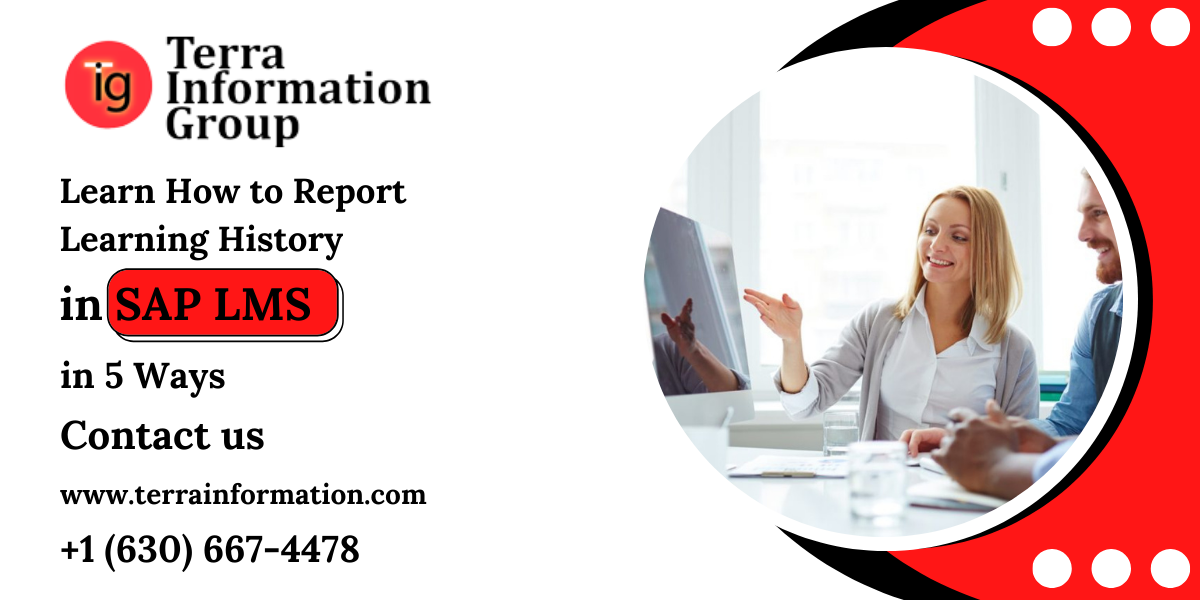Learn How to Report Learning History in SAP LMS in 5 Ways
When implementing any Learning Management System (LMS), including SAP Learning (LMS), it should come as no surprise that Learning History (LH) is a popular report. A company's competency and understanding of its employees is one of the most important metrics to measure. Moreover, in some industries, certain training is required as part of a compliance program, so being able to report on these training events is vital to success.
There is an obvious
optimization for running these types of reports in SAP LMS.
SuccessFactors knows that companies' system requirements may vary, so it offers
a variety of ways to retrieve this information. Taking this into consideration,
let's examine how SuccessFactors provides access to learning history and
explore the pros and cons of each style of reporting.
1) Standard Reports
Many users gain
access to reporting through the LMS admin. Prepackaged reports can be used to
access critical information without custom development and implement best
practices. There are prepackaged reports already created for learning history,
which is one of the most reported on elements in SAP LMS. Reports on
learning history and completion can be accessed by administrators via the
following standard reports.
Standard reports have
the obvious benefit of requiring no configuration beforehand. There is only one
downside to these reports: They cannot be customized or enhanced with
additional information.
2) Plateau Report Designer
SAP customers can use
the PLATFORM REPORT DESIGNER application to create custom reports and modify
existing reports so that they can upload them into the LMS web application,
where they can be published.
Clients can query the
learning history table via Plateau Report Designer and combine the data with
other data elements to create sophisticated reports. Below is a table of user
completion data that can be delivered by PRD's learning history table.
In addition, it is
useful to combine certain fields from the LH table with other important data
elements. The user in the table could be joined to the student table to include
additional information not contained in the LH table.
A benefit of PRD is
almost unrestricted access to LMS database information. There is a limit on the
total number of records that can be returned in one report when using this
method of reporting. Another thing to be aware of with PRD and reporting, in
general, is that there is no real-time capability, which means that a report
will be dated as of the time it is completed.
3) Learning
Intelligent Services
The intelligence
services are unique in the sense that they are the only way to report on
learning history outside of the learning management system. APIs that are
intelligent are event-driven, which means there isn't a call to an API broker
like in traditional API requests. They probably wait for some event inside the
application to trigger the API signal, which is then sent to a 3rd party
middleware tool. A learning item competes in the Learning History Intelligent
Services case.
This method provides
you with real-time updates of your data. In this integration, new learning
history records will be immediately sent to your chosen repository (typically a
local database). In spite of the time required to implement this method, the
end result is a complete and up-to-date record of your learning history.
4) Rest APIs
It is one of the
newer web services offered in SAP LMS. Instance calls are made with a
user ID and have the user's context, or the admin ID and the admin's context.
Customers can create custom portals much more easily since they can use the
user's context. Documentation for each service is available in the
SuccessFactors Learning Web Services - OData API Reference. Here are the LMS
Odata APIs that specifically relate to learning history and which can be
accessed through an API broker like Postman.
A benefit of using
the LMS APIs is that you can retrieve data in real-time using your chosen API
broker. This method has limitations, such as the number of records that can be
returned per call and the frequency at which calls can be made. This method is
not suitable for bulk data migrations due to this limitation.
5) LMS Data Services
Data from the SAP
LMS backend is provided each day in flat files as part of the Learning Data
Services service. SAP Professional Services implements this solution as part of
the LMS product license.
Based on three
different packages defined by use case, SAP SuccessFactors Learning data
extract creates Delta and Full data files. The tables related to Learning History
are part of package one, which is the most basic package of reports.
That's all there is
to it! SuccessFactors LMS offers five different ways to retrieve learning
history and certification information. Which Learning History solution is best
depending on your reporting needs and the middleware technology available. In
light of that, the fact that SuccessFactors allows so many different ways to
retrieve this data shows how much thought goes into its development.
Count on Terra
Information Group to continue offering a wide variety of HRMS solutions to meet
your reporting requirements. From SAP Recruiting to Learning. They can
help you get the best solutions for your company.




Comments
Post a Comment